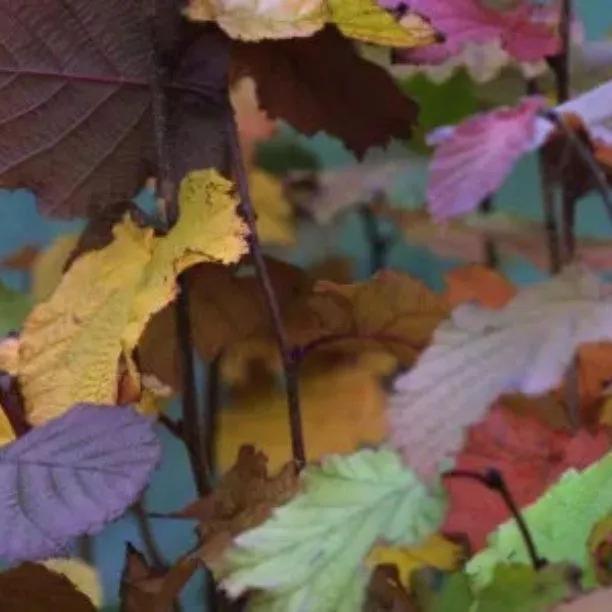Purple-Leaved Filbert Hazel Hedging

The details
Corylus a. maxima purpurea Filbert
Saplings / Hedge Plants
- Any moist soil.
- Great purple leaves
- Jumbled Autumn colour
- Vigorous, bushy tree
- Nuts inferior to other Hazels
- Not as shade-tolerant as Common Hazel
- Can be used as country hedging (but not native)
- Max. Height: 10m
- Bareroot Delivery Only: Nov-March
Recommended extras
Description
Corylus maxima Purpurea Filbert Hazel Hedging
Delivered by Mail Order Direct from our Nursery with a Year Guarantee
Purple Hazel, Corylus maxima Purpurea, is a variety of Filbert Hazel with superbly rich purple leaves, grown for its ornamental value in borders and garden hedges, rather than for farm or wildlife hedges, where Common hazel is best.
It is very hardy, suitable for any soil, and quite shade-tolerant, making it one alternative to Copper Beech (which needs sun and well drained soil).
Purple Hazel is a good a specimen tree, with long pink catkins in early spring that attract bees, followed by dark plum-purple foliage that turns into a jumble of different colours in autumn.
Note that this Corylus maxima Purpurea hedging is not the cultivar 'Red Filbert', but you will see it called Purple or Red (Leaf) Filbert around the place.
Purple leaf hazelnuts are edible like any other, but smaller than Cosford Cob, our recommended variety for nut harvesting.
It can reach about 8-10 metres.
- Any moist soil.
- Great purple leaves, good alternative to Copper Beech
- Jumbled Autumn colour
- Vigorous, bushy tree
- Nuts inferior to other Hazels
- Not as shade-tolerant as Common Hazel
- Can be used as country hedging (but not native)
- Max. Height: 10m
- Bareroot Delivery Only: Nov-March
All our sapling trees are measured by their height in centimetres above the ground (the roots or pots aren't measured).
Browse our full range of nut trees or see the full variety of fruit trees.
Spacing a Purple Hazel hedge:
- For a normal garden boundary hedge, plant at 3 plants per metre (every 33cm) in a single row. For security, mix in thorny plants such as wild roses and Hawthorn for a native wildlife hedge, or purple leaf berberis to match colours.
- A stock-proof country hedge requires 2 staggered single rows (i.e. start one row 16.5cm after the other), with 40cm between rows. That works out at 6 plants per metre in total.
- An interior, decorative garden hedge for can be planted at 2 plants per metre (every 50cm) in a single row.
Planting Instructions
Growing Purple Hazel plants:
Filbert Hazelnut will grow well in pretty much any conditions, except near the sea.
They are very tough plants that will grow in any soil and tolerate shade well, but we recommend planting them in full sun to get the best leaf colour if they are an ornamental specimen.
If your site is in full shade, we recommend using Green Filbert Hazel or Common Hazel instead.
Prepare your site before planting:
It is good to dig over the area where you plant a hedge several months in advance, especially if the soil is poor. Destroy the weeds first. Then dig the soil over; remove rocks, roots and other rubbish. Mix in well rotted compost or manure down to the depth of about 2 spades. If your soil is rich, you don't have to dig it over, but killing all the weeds is still necessary.
If you are planting Purple Hazel as a hedge instead of a cropping tree, the only essential preparation is to kill the weeds in a strip a metre wide along the planting site: improving the soil should not be necessary. If your soil is exceptionally poor and dry, then digging in some well rotted manure and/or compost is worthwhile.
Watch our video on how to plant a country hedge for full details on planting purple hazel in a mixed hedge.
Remember to water establishing plants during dry weather for at least a year after planting.
Hedge Planting Accessories:
Prepare your site for planting by killing the weeds and grass.
You can buy a hedge planting pack with sheets of mulch fabric and pegs to hold it down.
If you are planting in an area with rabbit and/or deer, you will need to use a plastic spiral guard for each plant, supported by a bamboo cane.
If your soil quality is poor, we recommend using mycorrhizal "friendly fungi" on the roots of new trees and shrubs.
You can also improve your soil with bonemeal organic fertiliser.


